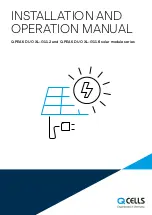
2.0
ENERGY
Energy is the lifeblood of our society. Whatever the source - oil, coal, hydro,
nuclear, gas- the use of energy is all-pervasive. Energy lights and heats our
homes, offices, and factories. It powers machines in industries and
transportation. The clothes we wear, the food we eat, the building we live and
work in, the goods we produce such as dye, lubricant, metals, glass, plastic, and
the services we render, such as transportation & communication - energy is
inextricably woven into it all.
Energy can be classified into RENEWABLE and NON-RENEWABLE. It has become
a reality that availability of Non-Renewable energy like fossils, hydro sites and
even uranium is finite. Renewable energy is one, which is available in abundance
and can be harnessed in an unlimited way.
Everyday Sun showers Earth with several thousand times the energy we use. In
other words the entire stock of fossil fuels on earth is not worth more than few
days of sunlight.
Solar energy can be effectively utilized in two ways - either by converting it into
heat (Solar thermal) OR electricity (Solar photovoltaic). A flat plate collector is
used to convert light energy into heat & a Solar Module is used to convert light
energy into electricity.
2.1
BASIC SOLAR WATER HEATING SYSTEM
A Solar water system consists of following major components:
A.
Solar Collector(s)
B.
Insulated Hot water Tank with Sacrificial Anode
C.
Indicating and Control Instruments (optional at additional cost)
2.2
Solar radiation falling on the collectors passes through the glazing and
is absorbed by the absorber consisting of fins, raisers and Headers.
Water contained in the header & raisers gets heated up and becomes
less dense than the water in the storage tank. On the principle of
“THERMOSYPHON”,
it starts rising through the collector and enters
the top of the hot water tank. Simultaneously cold water from the tank
descends to the bottom header of the collector, gets heated up in the
absorber and rises back to the hot water tank and the cycle repeats.
The movement of heated water from the collector to the storage tank,
placed above the collectors, is due to the difference of density only. No
other moving parts are required in the system and hence the system
reliability is very high.
The water retains its heat for a long time as the hot water storage tank
is insulated to prevent heat loss. The sacrificial Anode provided in the
hot water storage tank protects the system against Galvanic Corrosion.
Summary of Contents for Zing
Page 3: ...19 20...
Page 10: ......
Page 11: ......
Page 12: ......
Page 13: ......
Page 14: ......
Page 15: ......
Page 16: ......
Page 17: ......
Page 18: ......
Page 19: ......
Page 20: ...ALL DIMENSIONS ARE IN MM...
Page 21: ...SECTION 7 SCHEMATIC LAYOUTS 18 ALL DIMENSIONS ARE IN MM...
Page 22: ...ALL DIMENSIONS ARE IN MM...
Page 28: ......
Page 29: ......
Page 30: ...5...






































